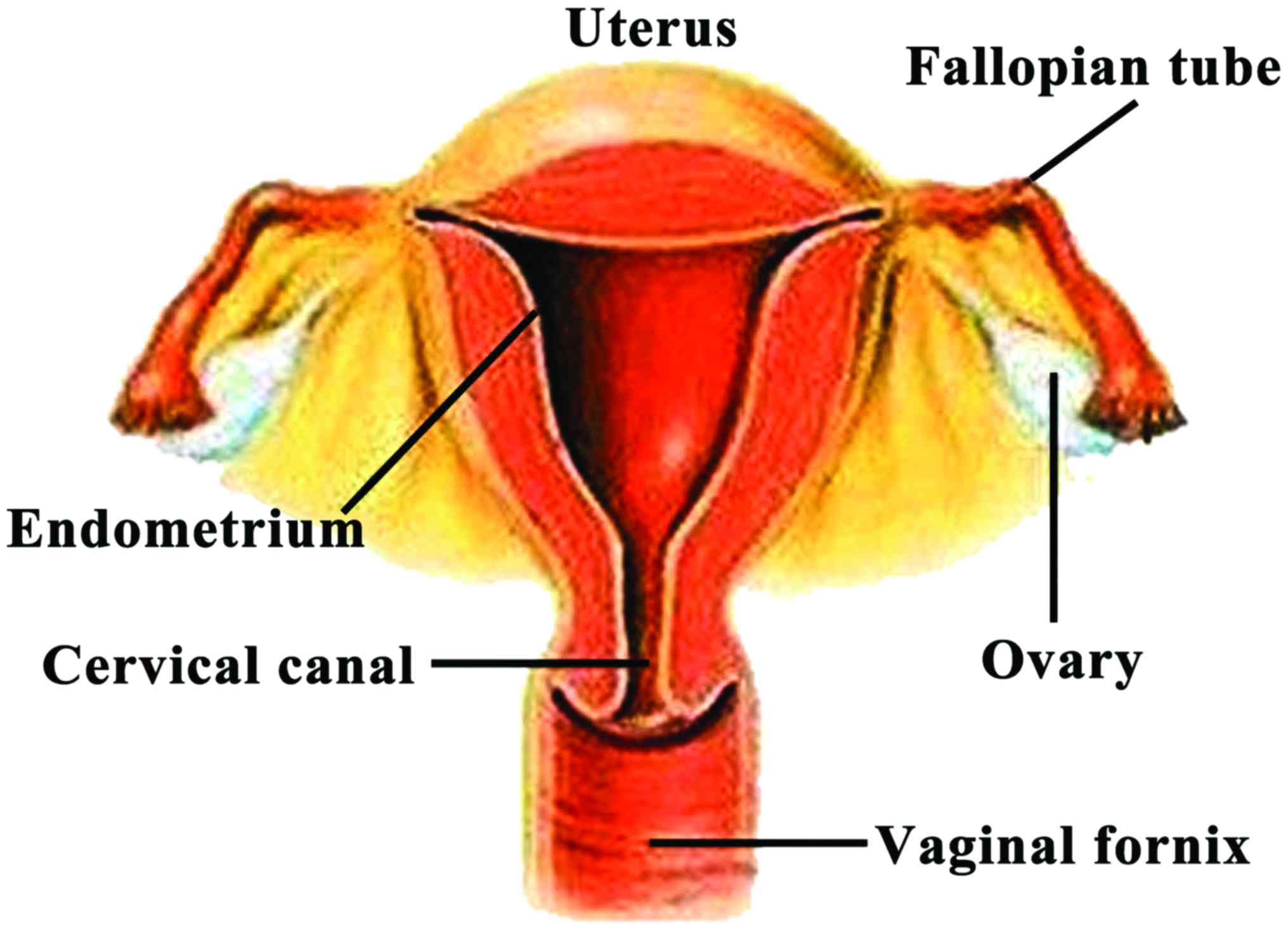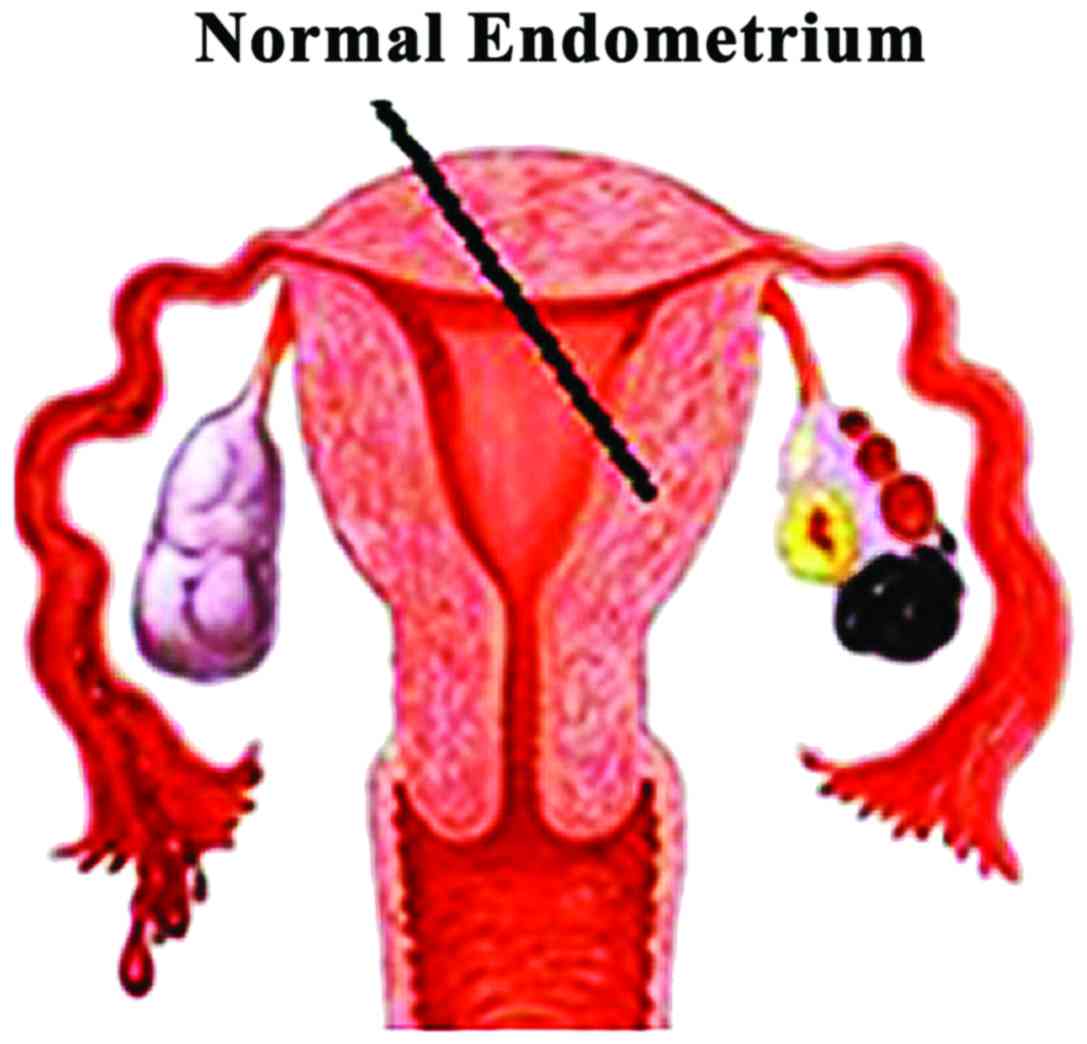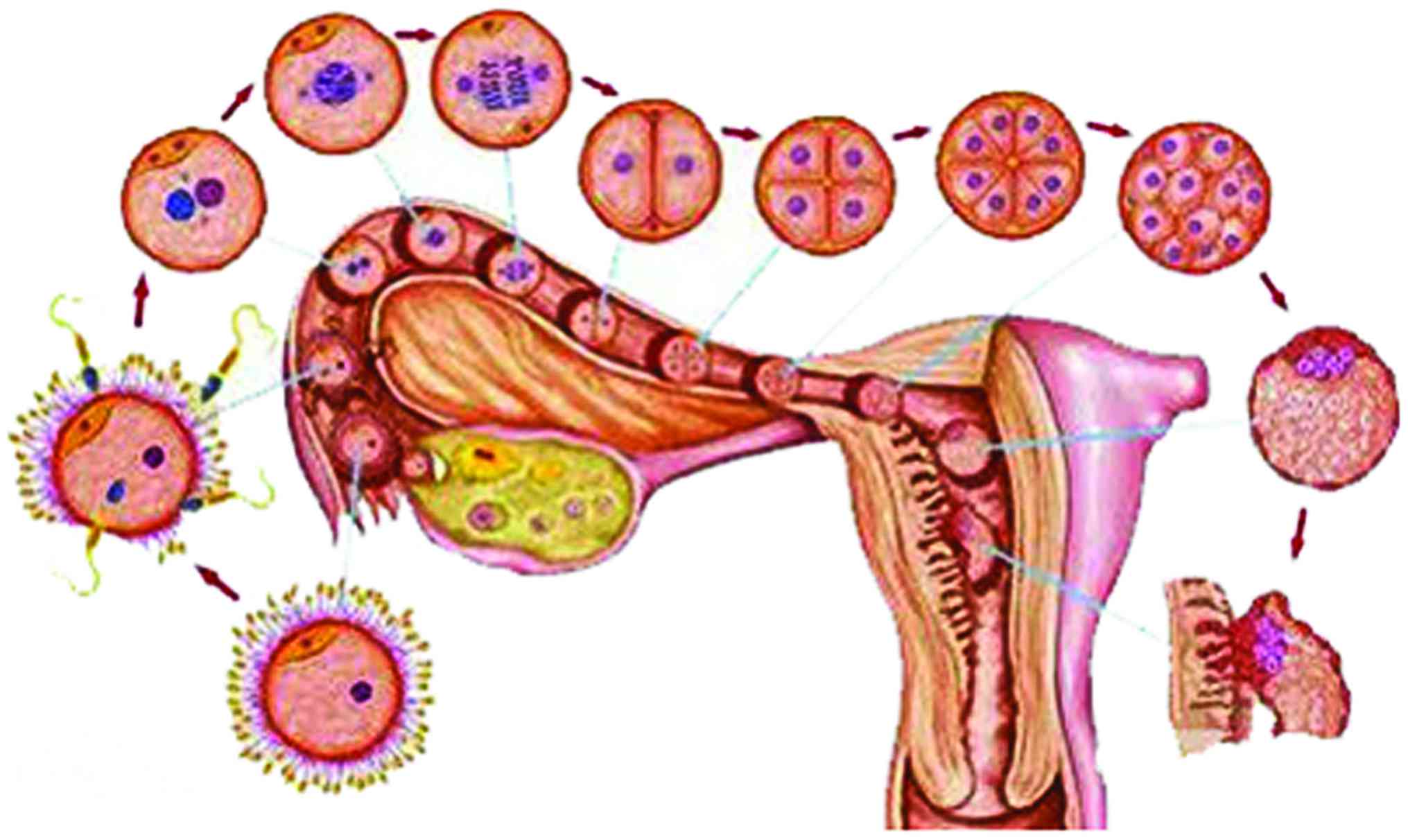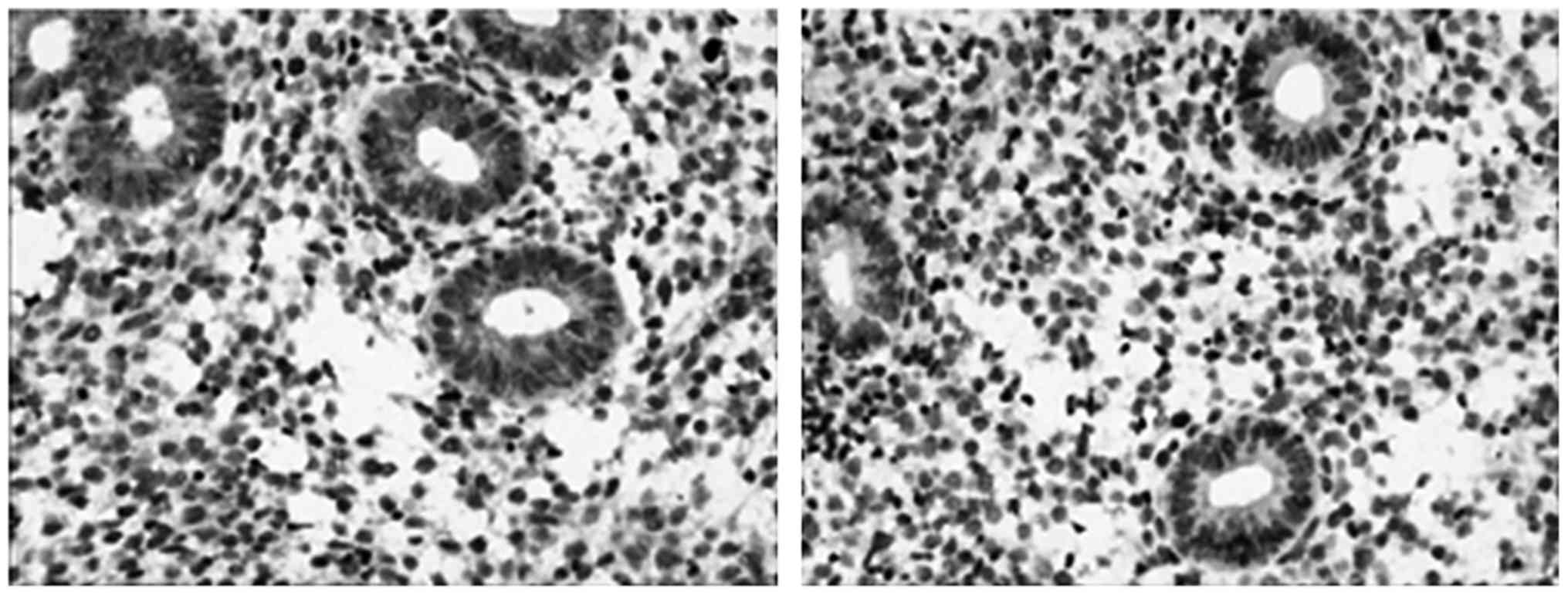Introduction
Unexplained spontaneous abortion, even repetitive
abortion, seriously impacts physical and mental health of female
population. Spontaneous abortion continued for three times or more
is recurrent abortion. With the changes in people's living habits,
as well as adjustment of dietary structure, currently, a gradually
increased population faces spontaneous abortion. According to the
data survey, recurrent abortion accounts for ~5% of all pregnancy
incidences. Among them, ~85% of recurrent abortion occurs in the
early stages of pregnancy, that is, within 12 weeks of pregnancy,
which means recurrent early abortion (1). So far, there is a lack of a unified
theory in etiology and pathogenesis of spontaneous abortion, which
has complex characteristics, and is subject to many factors, such
as heredity, infection, immune, and endocrine factors.
In unexplained spontaneous abortions, immune factor
occupies a high proportion, between ~40 and 60%, and
anti-endometrial antibody (EmAb) (Fig.
1) plays an important role. It takes endometrium (Fig. 2) as a target antigen, and destroys
structure of the endometrium via antigen-antibody reaction, thereby
affecting embryo implantation (Fig.
3) and development, resulting in early spontaneous abortion
(2).
In recent years, a wide range of traditional Chinese
medicine has been used in treatment of natural abortion patients,
with good effect and high safety and reliability. This study
investigated the effect of Shoutai pill on endometrial
receptivity.
Materials and methods
General information
This study was conducted in 160 patients with
spontaneous abortion (1–4 times), all of whom were treated in the
Fifth People's Hospital of Jinan (Shandong, China) from February
2014 to June 2016. The existence of severe organic disease such as
heart and kidney dysfunction, blood system diseases and mental
disorder was ruled out. This study was approved by the Ethics
Committee of the Fifth People's Hospital of Jinan. The studied
patients and family members had the right to know the treatment,
and signed the relevant informed consent. The 160 patients were
aged 24 to 38 years, with an average age of 28.7±2.2 years. Among
them, there were 32, 58, 43 and 27 cases, respectively, with 1, 2,
3, 4 spontaneous abortions. The patients' immune antibodies as well
as both of the couple's chromosomes, male semen quality examination
results showed no abnormal problems. The general data of all the
cases are comparable (P>0.05).
Method
After the patient's menstruation was clean, she was
instruct to take Shoutai pill comprising Eucommia ulmoides,
Cuscuta, Loranthus parasiticus, radix pseudostellariae,
Atractylodes and deer-horn glue, human placenta, Salvia
miltiorrhiza, teasel root and ramie root (3). The dose was 6 g per time and 3 times a
day, continuous medication for 20 days. Medication was stopped in
the menstruation, and continuous treatment was taken for more than
5 menstrual cycles. Based on the actual situation of the patient,
if abortion exceeded 3 times, intermittent treatment time should be
extended to 1 year, and contraceptive measures taken during the
treatment (4). Then, the patient was
tested for planning pregnancy based on the results. If B-ultrasound
monitoring shows ideal round follicles, while endometrium is in
good thickness and shape, the patient was instructed to have
intercourse. On the 12th day after ovulation, blood HCG was checked
as soon as possible. After the patient was pregnant, protection of
the fetus with Chinese and Western medicine was carried out until
12th week based on the test indicators, and records on the success
rate of pregnancy were kept (5).
Observation indicators
After treatment, vaginal ultrasound was used to
monitor the follicles. If at least one follicle was of 18–20 mm or
more, the urinary luteinizing hormone (LH) test strip was used for
monitoring LH peak of ovulation day. Vaginal ultrasonography was
taken to observe patient's endometrial thickness and morphology,
with statistics of hemodynamic parameters of uterine spiral artery
made, including pulsatility index (PI) and resistance index (RI)
(6). The endometrial morphological
classification was based on Gonen-related criteria. Wherein, type A
is typical three-line type, with strong echo line in the outer and
center and low echo area or dark area between the outer layer and
the uterine midline. Type B is moderate echo type, with
intermittent and unclear uterine strong echo midline. Type C is
homogeneous strong echo, without uterine midline echo. Within
cervix, the uterine artery was observed by horizontal and
longitudinal scanning of ostium uteri internum. The Doppler
spectrum image analysis was automatically performed by color
ultrasound, for pulsatility index and resistance index. Some
endometrial tissues of the uterine cavity was taken by the
endometrial sampler, and immunohistochemistry was used to determine
endometrial LIF level (7).
Statistical analysis
The data were analyzed and processed by SPSS 21.0
statistical software (IBM Corp., Armonk, NY, USA). The enumeration
data were expressed as (n, %) and tested by Chi-square. The
measurement data are expressed in mean ± SD based on t-test.
P<0.05 was the difference considered statistically
significant.
Results
Comparison of endometrial thickness,
PI and RI before and after treatment
As shown in Table I,
endometrial thickness, PI and RI improvement after treatment are
significantly superior to that before treatment (P<0.05).
 | Table I.Comparison of endometrial thickness,
PI and RI before and after treatment (mean ± SD). |
Table I.
Comparison of endometrial thickness,
PI and RI before and after treatment (mean ± SD).
| Time | Case no. | Endometrial thickness
(mm) | PI | RI |
|---|
| Before treatment | 160 | 0.74±0.19 | 2.15±0.68 | 0.81±0.04 |
| After treatment | 160 | 0.97±0.18 | 1.60±0.40 | 0.60±0.05 |
| P-value |
| <0.05 | <0.05 | <0.05 |
Changes in endometrial morphology
before and after treatment
As shown in Table
II, the patient's endometrial morphological improvement shows
significant advantages after treatment (P<0.05).
 | Table II.Changes in endometrial morphology
before and after treatment [n (%)]. |
Table II.
Changes in endometrial morphology
before and after treatment [n (%)].
| Time | Case no. | Type A | Type B | Type C |
|---|
| Before treatment | 160 | 80 (50.00) | 52 (32.50) | 28 (17.50) |
| After treatment | 160 | 120 (75.00) | 28 (17.50) | 12 (7.50) |
| P-value |
| <0.05 | <0.05 | <0.05 |
Expression of endometrial LIF
As shown in statistics of Table III, endometrial LIF expression
levels are obviously improved after treatment (P<0.05) (Fig. 4).
 | Table III.Expression of endometrial LIF. |
Table III.
Expression of endometrial LIF.
|
| Expression intensity
in epithelial cells |
|---|
|
|
|
|---|
| Time | − | + | ++ | +++ |
|---|
| Before treatment | 96 | 32 | 20 | 12 |
| After treatment | 65 | 40 | 32 | 23 |
| P-value | <0.05 | <0.05 | <0.05 | <0.05 |
Patients' pregnancy, safety
evaluation
After treatment, 136 cases had successful pregnancy
with pregnancy rate of 85%; during the treatment, 10 patients had
abdominal pain, nausea, diarrhea and other adverse reactions, the
symptoms were mild and subsided within 3 days. No serious side
effect was seen in the remaining patients.
Discussion
For blastocyst implantation, an important factor is
the ability of endometrium to accept the embryo, that is,
endometrial receptivity. If the endometrial tolerance is
inappropriate, ~60% of embryo implantation will fail. The data show
that endometrium thickness plays an important role in receptivity
prediction. In >80% of successful pregnancies, endometrial
thickness ranges from 9 to 12 mm, with ultrasound type of A
(8). In addition, intimal
pulsatility index and resistance index can well reflect endometrial
blood flow perfusion, and can be used as an important indicator of
endometrial receptivity in embryo implantation and pregnancy
prediction. At the same time, LIF, as a secretory glycoprotein, has
a wide range of biological functions. It has the largest secretion
in 19–25 day of menstrual cycle, which overlaps with endometrial
implantation, so it can also be used as an important indicator of
endometrial tolerance (9).
From the Chinese medicine point of view, in case of
kidney deficiency, uterus suffers from malnutrition, fetal origin
cannot be maintained, embryo cannot be implanted and causes
infertility, so reinforcing kidney to replenish essence, nourishing
the blood and promoting blood circulation, regulating menstruation
assisting pregnancy are essential to treatment (10,11). In
this study, Shoutai pill for treatment of the patients includes
Cuscuta as the main drug, supplemented by Loranthus
parasiticus, deer-horn glue and teasel root. With colla
corii asini to enrich the blood, plus deer-horn glue, Shoutai
pill can give full effect of replenishing kidney and promoting
generation of essence and blood. Human placenta can cultivate
Qi and blood, and can be used as drug for infertility, in
habitual abortion. Shoutai pill also comprises Salvia
miltiorrhiza to significantly improve microcirculation; while
such drugs as Atractylodes, Caulis Spatholobi, Astragalus
can sooth the liver, regulate vital energy, regulate menstruation,
tonify Qi, invigorate splenic yang, activate and
harmonize Qi-blood.
In this study, the results showed that treatment by
Shoutai pill could significantly increase endometrial thickness,
increase rate of endometrial type A, thicken endometrial spiral
artery, make spiral artery spectrum show low resistance in blood
flow, reduce PI and RI indexes. This indicates that Shoutai pill
can improve endometrial blood flow state and endometrial
receptivity, provide a good embryo implantation environment, and
improve pregnancy success rate.
In conclusion, for improvement of endometrial
receptivity, Shoutai pills can obtain good effect, significantly
promote embryo implantation and improve pregnancy rate. At the same
time, this treatment can significantly reduce the side effects.
With good safety and reliability, it is more easily accepted by
patients, enjoying great significance in promotion and
practice.
Acknowledgements
Not applicable.
Funding
No funding was received.
Availability of data and materials
The datasets used and/or analyzed during the current
study are available from the corresponding author on reasonable
request.
Authors' contributions
LZ and XD contributed to the conception and design
of the study. YX and XT collected the patients data. YX and PW
analyzed and interpreted the data. XD drafted this manuscript. XT
and PW revised it critically for important intellectual content.
All authors read and approved the final manuscript.
Ethics approval and consent to
participate
This study was approved by the Ethics Committee of
the Fifth People's Hospital of Jinan (Jinan, China). Signed written
informed consents were obtained from the patients.
Consent for publication
Not applicable.
Competing interests
The authors declare that they have no competing
interests.
References
|
1
|
Gao J, Deng G, Hu Y, Huang Y, Lu L, Huang
D, Li Y, Zhu L, Liu X, Jin X and Luo S: Quality of reporting on
randomized controlled trials on recurrent spontaneous abortion in
China. Trials. 16:1722015. View Article : Google Scholar : PubMed/NCBI
|
|
2
|
Pereza N, Peterlin B, Volk M, Kapović M
and Ostojić S: A critical update on endothelial nitric oxide
synthase gene variations in women with idiopathic recurrent
spontaneous abortion: Genetic association study, systematic review
and meta-analyses. Mol Hum Reprod. 21:466–478. 2015. View Article : Google Scholar : PubMed/NCBI
|
|
3
|
Lu KA and Chen HN: Effect of modified
Shoutai pill on anti-endometrial antibodies in patients with early
recurrent spontaneous abortion. Clin J Chin Med. 10:10–11.
2014.
|
|
4
|
Nowak R, Szewczyk K, Gawlik-Dziki U,
Rzymowska J and Komsta Ł: Antioxidative and cytotoxic potential of
some Chenopodium L. species growing in Poland. Saudi J Biol Sci.
23:15–23. 2016. View Article : Google Scholar : PubMed/NCBI
|
|
5
|
Ali MA, Farah MA, Al-Hemaid FM,
Abou-Tarboush FM, Al-Anazi KM, Wabaidur SM, Alothman ZA and Lee J:
Assessment of biological activity and UPLC-MS based chromatographic
profiling of ethanolic extract of Ochradenus arabicus. Saudi J Biol
Sci. 23:229–236. 2016. View Article : Google Scholar : PubMed/NCBI
|
|
6
|
Plasencia W, Barber MA, Alvarez EE, Segura
J, Valle L and Garcia-Hernandez JA: Comparative study of
transabdominal and transvaginal uterine artery Doppler pulsatility
indices at 11–13 + 6 weeks. Hypertens Pregnancy. 30:414–420. 2011.
View Article : Google Scholar : PubMed/NCBI
|
|
7
|
Wang CY, Ding CF, Zhang W and Wan LY:
Clinical study on the effect of Yulinzhu combined with Shoutai pill
on pregnancy rate of hormone replacement cycle frozen-thawed embryo
transplantation. China Mod Doct. 14:128–131. 2016.
|
|
8
|
Hashem A, Abd Allah EF, Alqarawi AA, Al
Huqail AA, Egamberdieva D and Wirth S: Alleviation of cadmium
stress in Solanum lycopersicum L. by arbuscular mycorrhizal fungi
via induction of acquired systemic tolerance. Saudi J Biol Sci.
23:272–281. 2016. View Article : Google Scholar : PubMed/NCBI
|
|
9
|
Aldahlawi AM, Elshal MF, Damiaiti LA,
Damanhori LH and Bahlas SM: Analysis of CD95 and CCR7 expression on
circulating CD4(+) lymphocytes revealed disparate immunoregulatory
potentials in systemic lupus erythematosus. Saudi J Biol Sci.
23:101–107. 2016. View Article : Google Scholar : PubMed/NCBI
|
|
10
|
Hyun TK, Kim HC, Ko YJ and Kim JS:
Antioxidant, α-glucosidase inhibitory and anti-inflammatory effects
of aerial parts extract from Korean crowberry (Empetrum nigrum var.
japonicum). Saudi J Biol Sci. 23:181–188. 2016. View Article : Google Scholar : PubMed/NCBI
|
|
11
|
Hu XS, Cheng DL, Li KJ, Wang LB, Yang X,
Sun S, Wang YP, Li SH, Lei ZF and Zhang ZY: Glucose consumption and
alpha-glucosidase inhibitory activities of aqueous root extract of
Helicteres angustifolia. Eur Rev Med Pharmacol Sci. 20:1423–1429.
2016.PubMed/NCBI
|


















